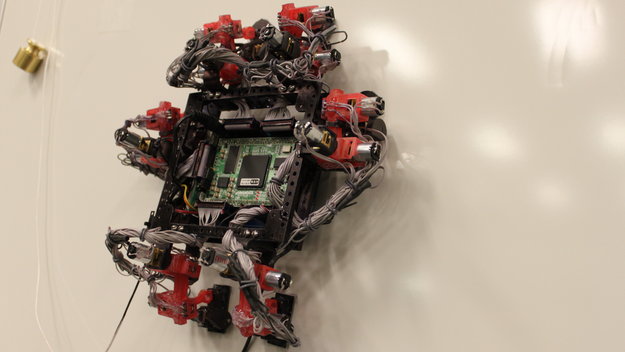Japan’s Latest Wall Crawler Robot
Uncategorized
 The latest wall crawler robot created by engineers from the Osaka City University Graduate School of Engineering in Japan under the guidance of Yogo Takada has created quite a stir in global technology circles. This is none other than the bridge inspection robot with special magnetic wheels which enables it to climb up walls. It can inspect bridges and scale walls thereby making the process a whole lot easier. Such robots are very useful when it comes to locating cracks on bridges and any other kinds of steel structures; special sensors and cameras on the robots help in providing accurate information about the surface they crawl on and its surroundings.
Wall crawling robots are not a new invention in this arena; however the technology used in this case is what makes Japan’s latest wall crawler different. Unlike traditional wall crawling robots which typically rely on a suction method to climb walls, this new wall crawler rides on four spoke wheels containing 8 magnets in each section. The advantage of this new technology is that it can even cling on to uneven structures. The new robot has been named BIREM which stands for Bridge Inspection Robot Equipping Magnets and is capable of moving at speeds of approximately 7.8 inches per second.
Reports have revealed that in San Diego, a similar robot has already been created with costs estimating to about $1000 less than what BIREM is expected to cost. This robot, named Skyweeper was created with the intention of surveying power lines.
The invention of this new technology through BIREM is expected to reduce bridge and other infrastructural inspection costs. However, the makers of this new wall crawling inspection robot have said that they will not start manufacturing it commercially before another three years. Robots are becoming an essential part of modern day technology and scientific progress too is set to go hand in hand with them.
The latest wall crawler robot created by engineers from the Osaka City University Graduate School of Engineering in Japan under the guidance of Yogo Takada has created quite a stir in global technology circles. This is none other than the bridge inspection robot with special magnetic wheels which enables it to climb up walls. It can inspect bridges and scale walls thereby making the process a whole lot easier. Such robots are very useful when it comes to locating cracks on bridges and any other kinds of steel structures; special sensors and cameras on the robots help in providing accurate information about the surface they crawl on and its surroundings.
Wall crawling robots are not a new invention in this arena; however the technology used in this case is what makes Japan’s latest wall crawler different. Unlike traditional wall crawling robots which typically rely on a suction method to climb walls, this new wall crawler rides on four spoke wheels containing 8 magnets in each section. The advantage of this new technology is that it can even cling on to uneven structures. The new robot has been named BIREM which stands for Bridge Inspection Robot Equipping Magnets and is capable of moving at speeds of approximately 7.8 inches per second.
Reports have revealed that in San Diego, a similar robot has already been created with costs estimating to about $1000 less than what BIREM is expected to cost. This robot, named Skyweeper was created with the intention of surveying power lines.
The invention of this new technology through BIREM is expected to reduce bridge and other infrastructural inspection costs. However, the makers of this new wall crawling inspection robot have said that they will not start manufacturing it commercially before another three years. Robots are becoming an essential part of modern day technology and scientific progress too is set to go hand in hand with them. You Might Be Interested In:
- Is TikTok Facing a US Ban? Decoding the New Law and Its Impact on Millions of Users
- Click, Buy, Pollute? Environmental Impact of Online Shopping and Ways for Sustainable E-commerce
- The High Price of Crypto: Environmental Cost of Mining and Solutions for a Greener Future
- Gemini Evolves: Your AI Assistant on the Go with the New Overlay Feature
Frequently Asked Questions?
01
Tech news
Is TikTok Facing a US Ban? Decoding the New Law and Its Impact on Millions of Users
Apr 27, 2024

01
Tech news
Click, Buy, Pollute? Environmental Impact of Online Shopping and Ways for Sustainable E-commerce
Apr 26, 2024

01
Blockchain
The High Price of Crypto: Environmental Cost of Mining and Solutions for a Greener Future
Apr 25, 2024

01
Tech news
Cloud Storage: Powering Progress or Polluting the Planet?
Apr 22, 2024
SUSBSCRIBE TO OUR NEWSLETTER
Join our subscribers list to get the latest news and special offers.
Is TikTok Facing a US Ban? Decoding the New Law and Its Impact on Millions of Users
Click, Buy, Pollute? Environmental Impact of Online Shopping and Ways for Sustainable E-commerce
The High Price of Crypto: Environmental Cost of Mining and Solutions for a Greener Future
Gemini Evolves: Your AI Assistant on the Go with the New Overlay Feature